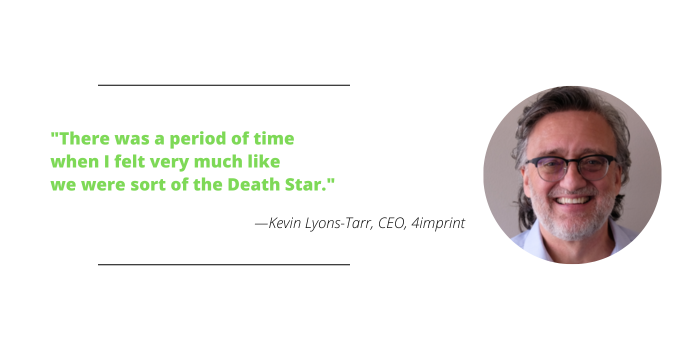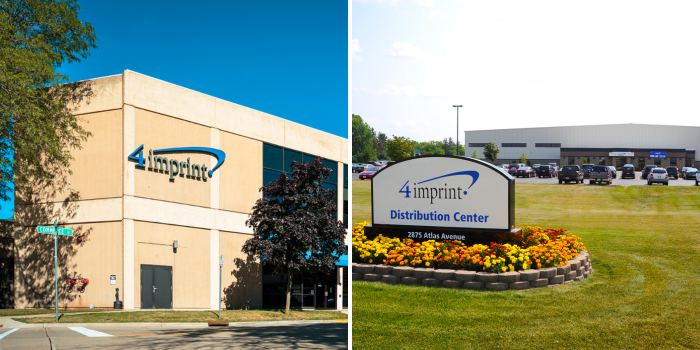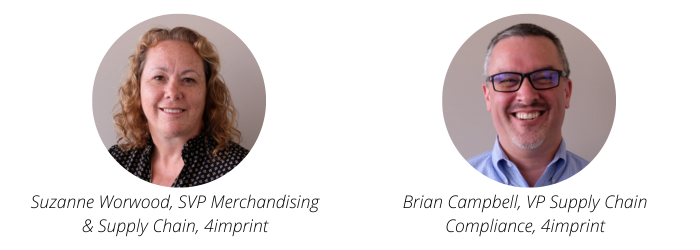4imprint: The Empire Is Here To Help
Now entering Oshkosh, population 66,816.
Crossing the city limits, the drive is tree-lined and lazy, with views of beauty shops and picturesque old cemeteries. There’s a left turn just before the Fox River, in front of the brewery, which gives way to a quiet downtown built close to the slow-rolling water.
It’s a sleepy approach. The mind wanders a bit while passing a candy shop and a bookstore. 4imprint’s Commerce Street address sneaks up on you that way.
This is the place? Yes, right here on the corner, across from a bank. Parking is around back.
It feels like a typical distributor in Anytown, USA, I think to myself as I walk through the front entrance expecting the usual product showroom. But there is nothing to show here, of course, since customers don’t really visit. And it’s not just any distributor. A publicly traded behemoth, 4imprint (PPAI 107200, D15) is the promotional products industry’s largest, now fresh off the biggest sales year of any distributor in history. 
CEO Kevin Lyons-Tarr greets me in the reception area with a smile and a handshake, the way the person in charge at any other small-town distributor might. He’s dressed in a simple button-down shirt and blue jeans, a pretty regular guy in a pretty regular town running a pretty irregular company. He and I walk past mazes of cubicles, now almost entirely empty, with most people choosing to work from home. We settle into a basic conference room upstairs, where he offers me a bottle of water and sits down across the table.
So, why Oshkosh?
Lyons-Tarr starts by professing that he’s been “a Cheesehead” for most of his life. “It’s Wisconsin, right? It’s small-town Wisconsin,” he says. “I like the people. It just comes back to that. And the Fox Valley is beautiful. ... It's a good place for your kids."
All but a few dozen of 4imprint's 1,570 total employs live in and around Oshkosh. Roughly 650 of them would be here in the office, the others at a distribution center across the river. Maybe a fifth of the HQ employees work in the office regularly anymore, and in fact Lyons-Tarr himself made a special trip in on this late-May Thursday.
The occasion is obvious. Never mind regaining its spot as the top seller, which everyone has known for months. 4imprint can now officially be called the leading distributor in the promo industry, according to our first-ever PPAI 100 calculation. Lyons-Tarr says he loves the approach we have taken for this new yearly project, considering not only last year’s revenue in the industry rankings, but revenue growth over the previous three years and all the other scoring factors.
His company raked in $1.12 billion in 2022. It scores among the best distributors for growth since 2019 (up 34% from $839.3 million). Naturally, it ranks for its online presence, innovation, responsibility and the faith the industry has in it – a measure of credit rating for distributors.
It is the earning of some of those latter high marks, I tell Lyons-Tarr, that interests me the most, because those represent positives for the industry as a whole.
4imprint’s online presence, i.e., how many pageviews its website gets, derives from its massive spend on marketing. It is the only distributor airing national TV commercials touting promotional products.
![]()
![]()
![]()
![]()
![]()
![]()
As an innovator in the selling of branded merchandise online, it has spurred other distributors to modernize their businesses over the years, boosting sales for many. Its success has helped to compel others.
4imprint is also known to use the weight of its purchasing power to steer industry suppliers toward safer and more sustainable product offerings, thus increasing the responsibility of the entire market.
This is industry leadership. It’s evidence that 4imprint, in so many ways, uses its force to create good in promo. And yet during my 18 months reporting on the industry, I have gathered the sense that a lot of typical distributors have historically viewed 4imprint with some dread.
After all, 4imprint markets directly to their clients. Many end buyers are aware of just two options for buying promotional products: There’s the distributor down the street, who they may know on a first-name basis. And there’s 4imprint, which claims it can usually get the job done cheaper and faster, with fewer complications. Other distributors do great work and compete hard for their share of business, certainly, but 4imprint has built quite a few advantages for itself.

Two decades have passed since Lyons-Tarr took over the company and turned it into promo’s galactic Empire by shifting its ecommerce model into hyperdrive. 4imprint has no doubt motivated other firms to improve their operations to be more competitive. But its looming presence has surely played a role in some distributors deciding to walk away.
“There was a period of time,” Lyons-Tarr tells me, “when I felt very much like we were sort of the Death Star.”
A Long Time Ago
Founded in Indiana by Dick Nelson under the name Nelson Marketing in 1985, the company had a direct marketing model well before the internet existed. In those days, the medium was catalogs.
Nelson grew the business until 1996, when he sold to a small U.K.-based public conglomerate, Bemrose Corporation. It took on the 4imprint name in 2000, and even as the ecommerce business found its early roots, the catalogs continued as a mainstay. Growth began to slow, however.
Lyons-Tarr, just into his 30s at the time, joined in 1991 after impressing executives during a one-weekend stint as a technical consultant. He held a number of roles in his first dozen years at the company, heading sales, operations and technology. Then in 2003, an activist private equity investor took on a controlling share of the company’s stock and led a sort of revolution that culminated in 2004 with Lyons-Tarr installed as CEO and a directive to get more serious about the online business.
READ MORE: See the full PPAI 100 rankings.
It was around a $50 million organization then, one of the industry’s larger distributors, though nowhere near its current stature. “When you’re faced with needing to get this thing growing again and trying to lead it to its fuller potential, you had to lean into the internet hard,” Lyons-Tarr says. “We needed to stop being a catalog company. We needed to be a promotional products business that happened to have catalogs, but it also had an internet presence.
“You started to realize at that time it wasn’t about catalog or internet. Those are marketing techniques you use to drive the business. It was about bringing customers the best possible service, bringing them the best range of products from very good suppliers.”
Suzanne Worwood, a native Brit who had joined the company as an import services director in 2000, got a promotion to merchandising VP around this time. Later earning a senior VP nod, she has become one of the industry’s most powerful executives. Working closely with Brian Campbell, 4imprint’s vice president of supply chain compliance, Worwood now carries arguably more clout with supplier partners than anyone else in the industry. She and Campbell oversee the sprawling product offering. Lyons-Tarr runs the business as a whole, including the nitty-gritty of responses to customer emails that hit his inbox, one method he uses to keep his finger on the pulse of buyer sentiment.
It all works. Apart from understandable downturns during the Great Recession and pandemic, the growth trajectory has been steady for these past two decades. 4imprint’s stock opened June 1 trading at $57.20 per share, nearly a 3,500% gain from 20 years prior.
Much of the acceleration began in 2018, when the company announced its five-year goal to reach $1 billion in annual revenue by the end of 2022. In spite of all challenges in the interim, it always seemed for certain that 4imprint would deliver the goods.
The Grand Plan
Covid sluggishness hampered its first quarter last year, but 4imprint quickly put itself on pace to be the first distributor to accomplish 10 figures in 2022, announcing in May that it expected to reach the milestone. David Seekings, another exec who traces back to the 1990s and 4imprint's CFO since 2000, cited a “particularly strong finish to the year.”
A rival in the race to reach $1 billion first, Illinois-headquartered HALO got there last year as well. But 4imprint topped its sales by more than $100 million. Seekings said the accomplishment “reflects clarity of strategy, the flexibility and resilience of the business model and the outstanding dedication of the team.”
DIDN'T GET THIS IN YOUR EMAIL? Subscribe to PPAI Newslink.
For a big, hairy, audacious goal to have been not only met, but significantly exceeded, it was actually more difficult than one might have predicted in 2018. When 4imprint announced its $1 billion target, it was already coming off a record year, having earned $608 million in 2017. That grew to just shy of $715 million in 2018. The $839.2 million in 2019 was more than double what it had earned five years prior, in 2014.
 Although its corporate headquarters in Manchester, England, almost all of 4imprint's 1,500-plus employees call one of two Oshkosh buildings their home base. It is one of the area's largest job creators.
Although its corporate headquarters in Manchester, England, almost all of 4imprint's 1,500-plus employees call one of two Oshkosh buildings their home base. It is one of the area's largest job creators.
Needless to say, 2020 didn’t go so well. The world changed with the onset of the pandemic. And suddenly the results started to change among promo’s largest distributors. 4imprint’s sales dropped almost 35%. HALO held steadier, and a few of the largest distributors even grew their businesses. According to the annual Counselor ranking of promo distributors’ sales, 4imprint came in third for 2019 revenue, and only narrowly ahead of fourth place.
While much of the industry had pivoted to items in immediate demand in 2020, such as masks and hand sanitizer, 4imprint did little business in PPE. There were other things 4imprint refused to change.
“We laid nobody off. We made it very clear that we were going to hang onto our team. And we continued to market,” Lyons-Tarr says. “Our philosophy throughout was that this will recover, and when it does, we need to put ourselves in position to take full advantage of the recovery. You trim back on everything else that you can.”
Among those employees who kept their jobs, of course, were Worwood and Campbell, who joined us in the conference room for the latter half of my visit. Roughly 40 people kick up to them in supply operations, merchandising development, product data and compliance and corporate social responsibility.
Amid the pandemic’s many challenges, these teams stayed busy rallying a more customer-facing focus on product sustainability. It was then that 4imprint began designing its Better Choices program, which has since launched as a curated offering of items with less environmental impact from within the company’s larger catalog.

“That was in the depths of Covid,” Worwood says. “For 2020 it was like, what is the framework? What do we need to learn?”
Emerging from that time, Better Choices is in some ways 4imprint’s effort to steer customers and suppliers alike to more sustainable products.
Campbell says, “I think we all hope as an industry that people will pay a little more for something that’s 100% recycled, and I think that’s what we want to do for the planet. So, yes, we do go out there and we do engage with our supplier partners. We don’t act as a customer with our suppliers. We act as a partner.
“I mean, we can’t grow unless we both do a good job. And that’s how we treat the relationship, and that’s where, in this area, I think we can lean into it.”
Better Choices currently highlights more than 6,600 products, which Worwood quickly points out is only the beginning. “That doesn’t now get a box ticked,” she says. “That’s the starting point, having something in place that we can use with teams, with suppliers, with ourselves to go, ‘All right, how do we now elevate this further, and what’s next?’”
Data is a big part of how 4imprint will judge its progress in driving buyers to Better Choices. It’s hard to imagine any distributorship doing more with the information gathered from its customers. 4imprint simply has more data to go on, owing to its early digital transformation.
“Our model does have advantages in that way,” Lyons-Tarr says. “There are a lot of customers to talk to. You can get really good, reliable, statistically valid information coming back to you to make good decisions.
“We look at it every day. I know how many orders we should be getting today, and I know how many of them should be coming from whom.”
An industry leading innovator, the company is constantly tweaking and refining its approach based on the customer data it collects. One of the dials that 4imprint decided to turn up at the onset of its five-year plan in 2018 was marketing, specifically to branch out from its focus on online advertising and begin pouring money into TV campaigns.
Lyons-Tarr wouldn’t get into details about 4imprint’s specific strategy on which audiences it targets with national campaigns, or why it advertises in this time slot or on that network. But he did say the strategy and tone of the 30-second spots is intentional and backed by customer research.
The ads don’t make much effort to appeal to customers’ emotions or sense of humor. They are simple and straightforward, reinforcing 4imprint’s promise to be a no-drama solution for business buyers in need of quality items, expertly decorated and delivered on time.
Although Lyons-Tarr considers the commercials a long-term investment in 4imprint’s brand equity and name recognition, the ads are crafted to elevate promotional products in general.
“We are very careful that we’re sending the right message,” Lyons-Tarr says. “I don’t think it’s an overt sales pitch or ‘Come in this weekend and take 20% off,’ that kind of stuff. It’s really trying to speak to the power that the products have and the service that we provide and that, you know, you’ll be well looked after.
“For most of the customers we work with, promotional products are not their main job, but they will tell you that they’ve got to be right. They’ve got to be on time. ‘I’ve got to have somebody I can trust. I want to be sure, because if things don’t go well, it doesn’t make me look good. It doesn’t make my company look good.’ For some customers, there’s a certain amount of angst associated with that, or dread. What we’re really trying to say is don’t worry about that. We’re here to help you. We’ll make sure everything goes as it should, and if it doesn’t, we’ll make it right.”
This Is The Way
As my visit to 4imprint winds down, there’s an obvious question left unasked: If the last five-year plan brought us promo’s only national commercial campaign, new standards for corporate social responsibility and the greatest sales year ever for a single distributor, what are the next big goals?
When it comes to technology and commercial marketing, there is no end in sight, only constant tweaking with new data. On the sustainability journey, Worwood isn’t ready to get specific, only suggesting that they’re just getting started: “It’ll outlive us all,” she says. She doesn’t dismiss the idea of greater attention on packaging. Cardboard 4imprint boxes are stacked high in the warehouses of most large suppliers these days.
And as for how much 4imprint can generate in sales in the next half-decade? Lyons-Tarr has something in mind, but he wants to get through 2023, the first full year removed from pandemic weirdness, before announcing anything. The idea, obviously, is scale, scale, scale. “We could’ve done more marketing last year and didn’t because we didn’t have the resources to handle the volume we were getting,” he says. “So, all that kind of needs to normalize. At that point, then you can really begin.”
I gather my things and snap a few photos on the way out. It’s mostly polite Wisconsin small talk as we pass the quiet rows of cubicles while heading to the non-showroom at the front entrance. I shake hands with Campbell, then Lyons-Tarr, then Worwood while saying goodbye. Lyons-Tarr offers his hand once more. I reach out mine again, absentmindedly, when he shakes his head at me.
“No,” he says, pointing at my left hand.
“Your water bottle. Let me recycle that for you.”
Ellis is the publisher and editor-in-chief at PPAI.

